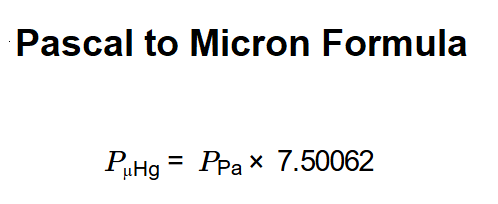 Home
Home
 Back
Back

Calculations are based on standard pressure unit conversions using the relationship between Pascals (Pa) and microns of mercury (µHg):
Unit Conversions:
| Unit | Conversion to Pa |
|---|---|
| Pa (Pascals) | 1 Pa |
| µHg (Microns of mercury) | 1 µHg = 0.133322 Pa (thus, 1 Pa = 7.50062 µHg) |
| psi (Pounds per square inch) | 1 psi = 6,894.76 Pa |
| MPa (Megapascals) | 1 MPa = 1,000,000 Pa |
| bar | 1 bar = 100,000 Pa |
| kPa (Kilopascals) | 1 kPa = 1,000 Pa |
| at (Technical atmospheres) | 1 at = 98,066.5 Pa |
| atm (Standard atmospheres) | 1 atm = 101,325 Pa |
| Torr | 1 Torr = 133.322 Pa |
| hPa (Hectopascals) | 1 hPa = 100 Pa |
| mmHg (Millimeters of mercury) | 1 mmHg = 133.322 Pa |
| inHg (Inches of mercury) | 1 inHg = 3,386.39 Pa |
Details: Accurate pressure unit conversion from Pa to microns of mercury is crucial for applications in vacuum technology, semiconductor manufacturing, and scientific research, where microns of mercury are commonly used to measure low pressures, alongside industrial and meteorological systems (using Pa, kPa, or hPa).
Tips: Enter a Pressure Value in Pa, and click "Calculate" to convert it to microns of mercury (µHg). Results include the converted pressure in µHg.
Q1: Why do I need to convert Pa to microns of mercury? A: Converting Pa to microns of mercury ensures compatibility between scientific and industrial systems, especially in vacuum technology and low-pressure environments where µHg is a standard unit.
Q2: Can this calculator handle negative pressure values? A: No, this calculator only accepts non-negative pressure values in Pa. Negative pressures may require specific scientific or engineering contexts not covered here.
Q3: What is the relationship between Pa and microns of mercury? A: 1 Pa is equivalent to 7.50062 microns of mercury, based on the standard conversion factor derived from the relationship between Pascals and millimeters of mercury (1 mmHg = 133.322 Pa).
Q4: Are the conversion factors exact? A: The conversion factors used are standard and highly accurate, but results may have slight rounding differences due to formatting (5 decimal places or scientific notation).